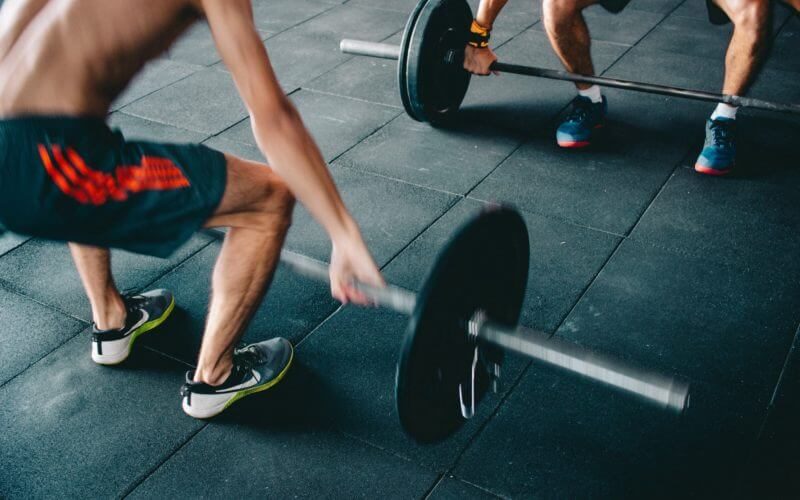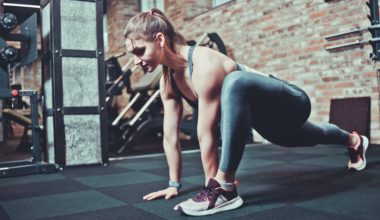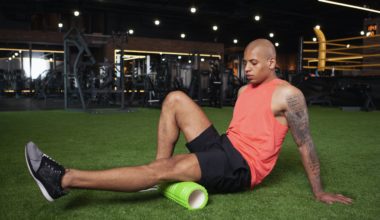The bent-over row exercise primarily targets your whole back. The entire combination of your rotator cuffs, rhomboids, traps, lats, etc. gets worked. The secondary targets are your biceps and shoulders. Even your glutes and hamstrings get some of the action. Every bodybuilder and power trainer considers the bent-over row to be a very significant part of their training, as it is known to build colossal back muscles and improve hypertrophy. The exercise is also performed regularly by athletes who want to increase their mobility. It is considered as a compound exercise because it works your entire body and therefore most of the cross fit trainers make it a part of their workout session.
Bent-over row can be performed with a barbell as well as dumbbells. The former is considered more effective than the latter owing to the increased balance and range of motion. However, more important than this is how the exercise is performed.
Form
Regardless of which exercise you perform, what’s most important is the way you do it. And the right way is called the ‘form’. Without proper form, any given exercise will not be able to deliver the desired result and may also result in a serious injury. Even bodybuilders and power trainers first train to perfect their form and then focus on increasing training volume. Follow the below instructions to develop the proper form for the bent-over row.
Step by Step Instructions
- Load a barbell with the desired weight and keep it on the floor right in front of you.
- Stand with your feet firmly on the ground and shoulder-width apart.
- Keeping your back absolutely straight, bend your knees and rotate your upper body forward.
- Grab the barbell using a firm palms-down grip.
- The distance between your palms should be a little wider than your shoulders.
- Lift up the barbell from the floor and let it hang keeping your arms straight.
- Tighten your abdomen while squeezing your shoulder and row the barbell upwards till it almost touches the end of your breastbone (sternum).
- Gradually lower it back down.
- Perform three to four sets of ten to fourteen repetitions with a weight that suits you best.
Common Mistakes
- Remember you have to pull up your elbows, not the barbell.
- When the barbell touches the sternum, pause, and hold. If you can’t pause, reduce weight.
- Your neck and spine should be aligned while performing this exercise.
- The right angle of the knee bend is 15 to 20 degrees. Anything more or less than this will reduce effectiveness and also cause strain on your knees.
- Your knees should not move throughout the exercise. Keep them rock steady.
- Some people perform this exercise while standing on a bench. This is a big NO!
- Do not round your back otherwise, it will end in lower back pain. Keep it straight.
- This is not an exercise for your arms. Pull the bar, don’t curl it.
- Don’t forget to exhale when you pull the bar.
- Don’t forget to inhale when you hang it down.
Safety & Precautions
- Always perform a 10-15 min warm-up before starting your workout.
- Performing stretching prior to working out will minimize the risk of injury.
- Wipe the bar with a clean cloth before you workout with it.
- Wear weight training gloves to prevent your hands from slipping.
- If you feel any pain in your wrists try wearing wrist wraps.
- If this exercise is new for you, try performing it with just the bar and no weight.
- Use the weight which you can easily work with.
- Wear a weight training belt when performing the bent-over row.
- Do not put the bar too close to your shins, you might end up hitting your knees.
- Perform a proper cool down after you are done with your workout.
- Keep yourself well hydrated throughout and after the workout.
Variations
The bent-over row can be performed in a number of ways. Some of them are explained below.
Dumbbell Bent Over Row
Although trainers consider the barbell the ultimate workout tool to perform resistance training but with proper form, dumbbells can also be used effectively for performing the bent-over row. You can also perform this variation to improve your form and then move to the barbell version. Select a pair of dumbbells that you can easily lift. Stand straight and keep your feet as wide as your shoulders. Keep the dumbbells in front of you on the floor so that they are facing outwards. Bend your knees and lift up the dumbbells. Keeping your elbows locked with your body, lift them up till they touch slightly lower than your chest, and then return to the starting position.
Kettlebells Bent-Over Row
You can perform this variation by using kettlebells instead of dumbbells. The method will be exactly the same. However since kettlebells tend to rotate your wrists owing to their special shape, make sure you do not rotate your wrists.
One-Arm Bent-Over Row
If you are finding it hard to perform the bent-over row with the barbell, or you have an issue with your form, try performing the same exercise using a dumbbell with each arm one by one. Select a dumbbell weight you can conveniently use. Keep the same side knee and palm on a bench so your upper body should be almost parallel to the floor. Lift up the dumbbell from the ground and perform a row by pulling the dumbbell upwards until its inner edge touches your lower chest. Perform 10 repetitions and then repeat the movement with the other arm.
Pendlay Rows
Introduced by fitness trainer, Glenn Pendlay, the primary difference between this variation and the standard bent-over row is that every time you perform a row, you put down the bar on the floor and lift it again. The other difference is that your upper body remains almost parallel to the floor. This makes the exercise harder and more effective by engaging your back muscles to make more effort.
T-Bar Row
This exercise is performed on a ‘landmine’ or T-bar. If it is not available, take a barbell and place one of its ends against any corner in the room, with the bar laying on the floor. Put some weight on this end so that the barbell does not lift up from the other end. Load some weight plates at the other barbell end. Keep your feet on the sides of the bar so that the bar seems to be passing right through your legs. Grab a V-handle. With your knees slightly bent, lean forward till your chest is at an angle of 45 degrees from the floor. Use the V-handle to lift up the bar from the loaded end until it touches your chest. Pause. Hold. Repeat. Some trainers perform both the standard bent-over row and the T-bar, one after the other, and consider them to be distinct exercises.
Inverted Rows
You can use a squat rack or smith machine for performing the inverted rows. Position a barbell on the squat rack or use the smith machine’s bar. The bar should be as high as your waist. Grip the barbell about shoulder width apart and get underneath it with your legs straight and heels pushing against the floor, exactly like a hanging position. Flex your elbows and pull yourself towards the bar till it almost touches your chest. Pause and repeat.
Yates Row
This variation of the bent-over row was developed by the famous bodybuilder, Dorian Yates. It differs from the standard bent-over row in two ways. First, it assumes a more upright position for your upper body at an angle of 30 to 45 degree from the ground. Second, instead of the overhand grip it uses the reverse grip. Stand as you would while performing a standard row, bend your knees so that your upper body is at an angle of 45 degrees. Without rounding your back, kneel forward and grip the barbell with an underhand grip. The grip should be shoulder width apart. Perform the row by pulling in your elbows, squeeze your shoulders and tighten your abdomen. Pause and hold when the barbell touches your chest. Repeat the movement. This variation is usually performed by advance trainers who have already perfected the standard bent-over row.
Benefits
- The bent-over row works out your whole body and is considered to be a very effective compound exercise.
- It strengthens your entire back; progressive overload results in big back muscles.
- The rowing motion improves the mobility and range of motion of your upper body.
- Perfecting the form of bent-over rows will also strengthen your elbows and biceps.
- Performing bent-over row exercise will improve your performance in other exercises such as deadlifts and bench press.
- Greatly helps in improving body posture and alleviating lower back pain.
- Bent-over rows reinforce your hip and pelvic muscles.
- The bent-over row is considered to be a compulsory exercise for powerlifting, bodybuilding and cross fit training.






